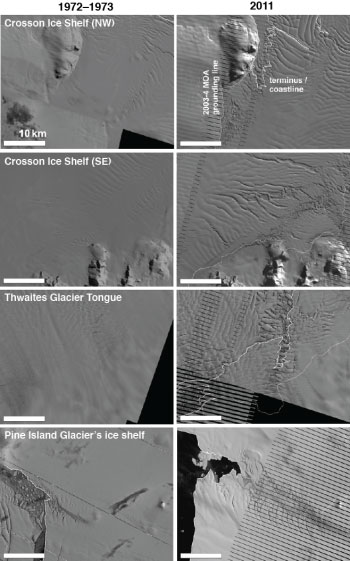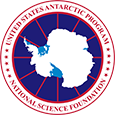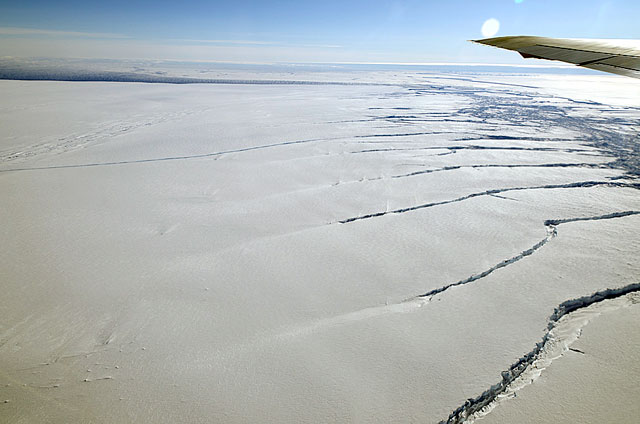Slipping awayIce shelves in West Antarctica losing their gripPosted April 13, 2012
A new study examining nearly 40 years of satellite imagery has revealed that the floating ice shelves of a critical portion of West Antarctica are steadily losing their grip on adjacent bay walls, potentially amplifying an already accelerating loss of ice to the sea. Analysis of the ice shelves imagery in the eastern Amundsen Sea Embayment in West Antarctica shows that their margins, where they grip onto rocky bay walls or surrounding ice, are fracturing and retreating inland. As that grip continues to loosen, these already-thinning ice shelves will be even less able to hold back grounded ice upstream, according to glaciologists at The University of Texas at Austin’s Institute for Geophysics (UTIG) Reporting in the Journal of Glaciology, the UTIG team found that the extent of ice shelves in the Amundsen Sea Embayment changed substantially since the launch of the first NASA-USGS Landsat 
Pairs of Landsat satellite images show changes in ice shelf margins in the eastern Amundsen Sea Embayment in West Antarctica between 1972 and 2011. The striping visible in the 2011 images is due to an unrepaired malfunction in the Landsat-7 platform that occurred in 2003.
“Typically, the leading edge of an ice shelf moves forward steadily over time, retreating episodically when an iceberg calves off, but that is not what happened along the shear margins,” said Joseph MacGregor “Anyone can examine this region in Google Earth and see a snapshot of the same satellite data we used, but only through examination of the whole satellite record is it possible to distinguish long-term change from cyclical calving,” MacGregor said in a press release The shear margins that bound these ice shelves laterally are now heavily rifted, resembling a cracked mirror in satellite imagery, until the detached icebergs finally drift out to the open sea. The calving front then retreats along these disintegrating margins. The researchers believe the pattern of marginal rifting and retreat is a symptom, rather than a trigger, of the recent glacier acceleration in this region, but this pattern could generate additional acceleration. “As a glacier goes afloat, becoming an ice shelf, its flow is resisted partly by the margins, which are the bay walls or the seams where two glaciers merge,” explained Ginny Catania The UTIG team found that the largest relative glacier accelerations occurred within and upstream of the increasingly rifted margins. The observed style of slow-but-steady disintegration along ice-shelf margins has been neglected in most computer models of this critical region of West Antarctica, partly because it involves fracture, but also because no comprehensive record of this pattern existed, according to the authors, who conclude that several rifts present in the ice shelves suggest that they are poised to shrink further. NSF-funded research in this article: Ginny Catania and Donald Blankenship, The University of Texas at Austin, Award No. 0739654 |



For USAP Participants |
For The Public |
For Researchers and EducatorsContact UsNational Science FoundationOffice of Polar Programs Geosciences Directorate 2415 Eisenhower Avenue, Suite W7100 Alexandria, VA 22314 Sign up for the NSF Office of Polar Programs newsletter and events. Feedback Form |


